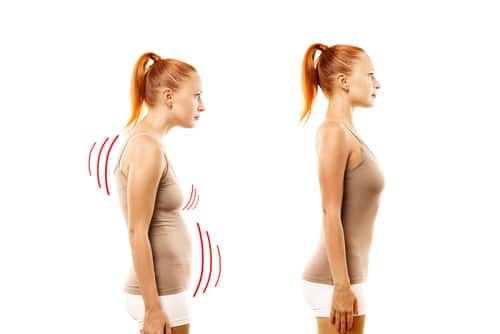
Ideal Posture
Normally, the spine is aligned through what is known as a plumb line–this is just an imaginary vertical line that goes straight down the body through the C7 vertebra in the neck. In this alignment, there is still always some natural S-shaped curvature. The upper or thoracic back rounds outward into the kyphotic curve, while the lumbar or lower back rounds inward into the lordotic curve. This curvature helps the spine bear more weight and handle the natural bending and twisting you have to do on a daily basis.
The Three “Bad” Postures
There are basically three types of “bad” postures that people develop over time. All of them negatively can affect the spine if not properly addressed.
Flat Back
In flat back posture, you lose much of the lordotic and kyphotic curves in the spine. It’s most common for the curvature loss to be primarily in the lumbar spine, but you might lose curvature in the upper back or both the upper and lower back, too. Subsequently, instead of a nice S shape, your spine has a more straightened appearance. There are many causes of flat back, but in terms of posture, one of the biggest contributors is having the pelvis “tuck under” with a posterior tilt, moving the tailbone forward. The hip flexors and quadriceps, which are responsible for bringing your leg up toward your chest, are usually too tight, as are the abdominals. The hamstrings, gluteal muscles, and muscles of the lower back tend to be weak.
Sway Back
With sway back, the lordotic curve of the back is exaggerated. The front of the pelvis usually moves downward. Often, this is because the abdominal muscles (particularly the lower ones) are too weak when compared to the muscles of the lumbar spine. The hip flexors and quadriceps are usually weak, as well, and the hamstrings are often tight. Very often, you see this posture in pregnant women, who have their abdominal muscles significantly stretched and who have to compensate for more weight being in the front of the body. People with weight issues sometimes have this posture, too.
Kyphotic-Lordotic
This posture is very similar to sway back in terms of the pelvic rotation and muscular imbalance. It is different, however, in that there is more exaggeration of the kyphotic curve. This generally happens because an anterior rotation of the pelvis essentially causes you to look upward. To compensate and keep looking straight ahead, most people end up rounding or hunching their shoulders and upper back.
Exercises for Each Poor Alignment
For a flat back, your main goal is to strengthen the back of the body so that the pelvis will rotate posteriorly back into a more neutral position. Hamstring and gluteal exercises such as bridges, leg curls on an exercise ball and straight leg extensions will help. You also can do exercises such as supermans for the lower back.
For both sway back and kyphotic-lordotic posture, your objective is to strengthen the front of the body and rotate the pelvis anteriorly. Exercises that strengthen the abdominal muscles, such as the teaser, boat pose, and crunches (any type) help accomplish this. Exercises such as lunges and squats, as well as anterior leg lifts will strengthen the hip flexors and quadriceps.
In all three types of bad posture, the head comes forward, causing the shoulders and upper back to round to some degree. The chest muscles are typically tight, and you also usually have tight muscles in the back of the neck because they are trying to keep your head up despite it being off its ideal center of gravity. The muscles in the front of the neck and upper back are often weak. Simply getting onto your back and trying to lift your head up can strengthen the front muscles of the neck, or you can try to do repetitions of bringing your chin toward your chest. Exercises such as rows and pull-ups are excellent for both the upper back and shoulders.
Keep in mind that, as you do the strengthening exercises for your specific type of posture, you will want to do some stretching of whatever muscles are tight for you. For instance, since these postures normally involve tight chest muscles and a weak upper back, you can do stretches such as clasping your hands behind your back and lifting them gently upward within your range of motion.
Conclusion
All three types of poor posture–flat back, sway back and kyphotic-lordotic–can cause minor to significant pain. Exercises can correct this, so long as you understand which muscles are tight and weak with the posture you use. Your doctor or a spinal specialist can help you make this determination if you are unsure.
Related Articles By Cathe:
6 Things That Happen If You Sit Too Much
The 3 Most Common Posture Problems and How They Jeopardize Your Health
Shoulder Shrugs Don’t Get the Attention They Deserve & Why You Need Them
3 Common Posture Problems and Ways to Correct Them with Exercise

